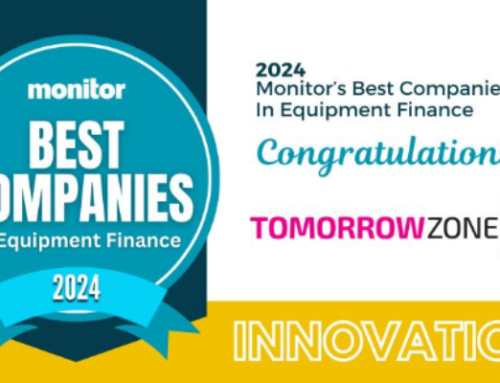
This article was originally published by MonitorDaily in December 2022.
Reprinted with permission from the author.
Working hard can spark innovation, but working too hard can lead to burnout. Deborah Reuben spoke with Rachel Sheerin, a public speaker and Certified Professional Behavioral Analyst, about how to identify and combat burnout to help people succeed.
A state of physical, mental and emotional exhaustion caused by prolonged or chronic stress, burnout can lead to feelings of hopelessness, cynicism, detachment and being overwhelmed. In my innovation and transformation work, I often encounter leaders and team members struggling with burnout. I sat down with burnout expert and behavioral analyst Rachel Sheerin to learn how we can recognize the signs early and avoid burning ourselves and our teams out as we navigate disruption and shape our future. The following is our interview (edited for clarity and conciseness).
Deborah Reuben: How would you describe yourself?
Rachel Sheerin: I’m a burnout prevention and employee engagement consultant, emcee and keynote speaker. I’m a traveler, margarita lover, pit bull dog mom, wife and sister. I’m so many other things than what I do. And I say this because, when it comes to burnout, statistics show Americans identify themselves with their work. The past few years reminded us that everything could change overnight and nothing’s guaranteed.
I’m passionate about burnout because I loved my career and my team, crushing sales numbers, growing and exceeding goals, but there’s more to life than that. While most Americans identify with their work, 24% are unhappy in their life, according to a recent Gallup poll. Burnout happens to high performers and people who care way too much. When you’re unhappy in life, you might escape by working. When you identify as your job but are unhappy at work, it spills into everything. I’ve done years of research and work with large organizations, small businesses and franchises; I’m on a mission to create cultures that prevent burnout and boost happiness.
Reuben: What was the catalyst for your research focus?
Sheerin: Everything on the outside looked great — a promotion, corner office, six-figure salary and winning awards. But, inside, I was a mess, crying on the way to work and home, eventually leading to a meltdown. In one fell swoop, I lost my income [and] quit on a team I loved, one I cared for and built myself. I left my career, legacy, reputation, association and colleagues.
In love with being a high performer and overachiever, I let burnout, the dirty little secret, take hold of me. Trying to outwork, out-succeed and out-buy my burnout didn’t help. During those years, I funneled lots of money into escaping, trying to “self-care” my way out of feeling so bad. No amount of massages and pedicures can help burnout.
On airplanes, they say to put your mask on before helping others. I’ve been on a plane where masks have dropped. That instinct to help others before yourself is real. People got up to help strangers, much to the flight attendants’ concern. Everything turned out fine in that scenario. I didn’t need to be on that plane to know that’s what people would do, especially women.
Burnout came for me. I quit my job and lost so much, leaving me wondering, “If not this, then what?” St. John of the Cross calls it “the dark night of the soul.” It wasn’t the workload that led to burnout. I like hard work, building teams and succeeding. But I couldn’t figure out the connection between why I felt so bad, why things I loved hurt me. Could I have a different identity and move on?
As leaders, we can often underestimate our influence. As Michelle Obama said, “When the door of opportunity opens, and you walk through it, make sure you pull someone through with you.” I’m walking through doors of opportunity, preventing burnout and building cultures of happiness and success for those who come through the door behind me.
Reuben: Is burnout different for women and men?
Sheerin: Again, research shows that one in four Americans is unhappy. Studies show that 50% of employees have different employer expectations than before the pandemic, which is scary and an opportunity for innovation. When asking somebody what they want, often they don’t know, so it becomes a financial conversation, more money. That’s fair and valid, but it’s more than that. What conversations are we having as leaders? We must create safe environments to help people discover what they want, helping them think it through.
Burnout is different for women, showing up as exhaustion, cynicism, fatigue and apathy when love goes out of your work. Women tend to do the most unpaid work, [such as] child-rearing, caregiving, housekeeping and more. There are different expectations and assumptions about this work that it’s not susceptible to have negative thoughts. And that’s not true. For example, caregiving fatigue or dealing with prolonged illnesses can lead to resentment and negative thoughts, contributing to burnout. Again, women are disproportionately affected by this.
Reuben: Are innovation and burnout connected?
Sheerin: Absolutely. It’s almost impossible not to see it because change is the core of both innovation and burnout. So, are we going to embrace or resist it? First, we must honor that change is also a loss. When we innovate, we lose the way things were. That can be scary, especially in a world that is changing/losing a lot. You could stay in the pit of despair, but this is not an option for high performers. It doesn’t mean we won’t go through valleys on the way to something better, different and more meaningful.
My research and work with Fortune 500 companies reveal that when you have a strong innovation pipeline and forward-thinking culture, what we do in those lows can make or break the initiative. What we do in those hard times, in the deserts of creativity, can impact our budget and ability to fuse as a team, especially legacy employees. Happy legacy employees are the highest-value currency in the working world today. They’ve been with you, understand you, embraced change and stayed on loving the ride.
Reuben: How can we balance high performance and self-care?
Sheerin: A recent Wall Street Journal study with Harvard Medical School asked senior leaders about burnout, and 96% feel somewhat burned out, and a third described it as extreme. Yet only 11% told someone about it.
The mirage of leadership is perfection, almost stoicism and eternal strength. In reality, no one is the same since 2020. The problems, stressors and challenges made us more raw.
High performers seeking balance need to reflect on essential questions. What are your values? Are you living your values? Where do you spend your time and money? For instance, show me your calendar. If you say you value friends, family and faith, why is it only filled with business meetings? Where are the family dinners, friendly meetups and the like? Not living your values can lead to burnout.
Hard work is just an action or ethos, not a value. High performers, ask yourself: Why are you working so hard? Where did you learn that success means suffering? Who do you know that’s succeeding and enjoying their life? Identify what you value and where you spend money and time and adjust accordingly.
Reuben: How do I approach my manager about burnout?
Sheerin: Curiosity is a great way to start the conversation when unsure of your footing or whether you will be supported or judged. For example, you could ask them, “Have you ever struggled with burnout? How do you balance your time?” You could admit to seeing boundary bleeds and ask for help dealing with it to make your leader aware. Be aware of how often you say yes and no. If I say yes to this, I must say no to something else or delay the project by this much.
Everything comes at a cost. Burnout flames grow stronger when you present at work like someone with no limits. But we all have limitations that constantly change. A baby up all night, an intense family discussion and even grief can impact your limits. Burnout, like grief, is very personal. There’s not a one-size-fits-all model. That’s where curiosity, courageousness [and] empathy are essential for these conversations.
Another transformative approach is stacking yeses. Say, “Are you and I having a great conversation?” Yes. “Do you care about me as a person?” Yes. “I need help, but I’m worried about you judging me as weak; can you help me?” Yes. Doing this opens up trust, closeness and vulnerability, allowing the leader to help.
Reuben: How can leaders identify burnout?
Sheerin: Leaders should consistently check in and watch out for people not acting like themselves for a prolonged period or over a few days. I appreciated leaders who gave me the autonomy to make my own decisions. Still, I wish they had checked on me more often. So, check in on your strong team members consistently, especially in difficult times; when you see something, say something.
Don’t just ask, “What’s going on with you?” That puts the ownness on the person struggling. Say instead, “A lot has changed lately, has anything changed for you? What has stayed the same? What are you enjoying about work?” Find out if they are working in the areas of their strengths. Address this as a team regularly.
Leaders, it starts with you. You can support team members through continual evolution with confidence and trust. Hold up a mirror to yourself and ask, “Am I exhibiting and perpetuating burnout culture? Are my expectations unrealistic? Am I pushing my burnout onto others?” If you ignore the flames of burnout, it can engulf your personal and professional life.
Reuben: How might we determine the root cause of burnout?
Sheerin: First, get curious about yourself and your team. Are your expectations out of line? Is it possible that what you want for others is not what they want for themselves? Often people strive after goals not because it’s what they want, but because someone else said that’s what they should do, leading to burnout.
I was that person. When I was promoted to the C-suite, I thought I had made it. It was great, but I was miserable. It’s not what I loved and wanted; it’s what I thought was expected of me, which hurt me.
When identifying the root cause, acknowledge burnout is not a one-time event or a one-size-fits-all thing. The goal here is not never to feel the flame of burnout, but to recognize when you start to feel the heat so you can adjust your direction.
I help organizations identify what people perceive as burning them out. We have to listen to what people say. It may be hard to hear at first that something is not good. Many strategic conversations go sideways when we care more about defending something than helping someone.
Reuben: How can leaders act today to shape tomorrow?
Sheerin: Value happiness and know that happiness leads to increased success. A University of California study asked does success make you happy or does happiness make you successful? Across industries, data revealed happiness is a precursor to success. There are many correlations between happiness and success, but researchers were surprised by a third element: When you’re happy and successful, you’re more generous. Giving makes you happier and leads to more success. We should pursue and model this cycle. Don’t delay until after you retire, finish the project or upgrade this or that. Instead, be happy and enjoy success now.
Rachel Sheerin is a burnout expert, a Certified Professional Behavioral Analyst, an award-winning keynote speaker, an event emcee and the forthcoming author of “Happy Success: How to Battle Burnout and Win at Work, Life and Legacy”. She is also the co-founder of The MAGNET Method, an employee retention and engagement consulting firm. Learn more at rachelsheerin.com.
Deborah Reuben, CLFP, is CEO and founder of TomorrowZone, a technology strategy consulting firm bringing forward-thinking insights and original ideas to help companies gain efficiencies and design roadmaps for the future. She holds many equipment finance industry leadership positions and authored The Certified Lease & Finance Professionals’ Handbook sixth to ninth editions.





